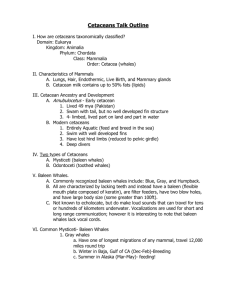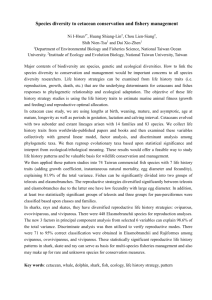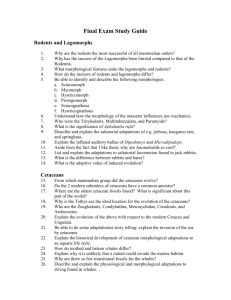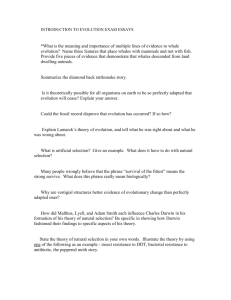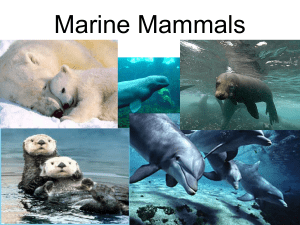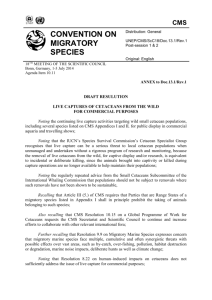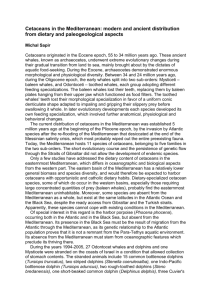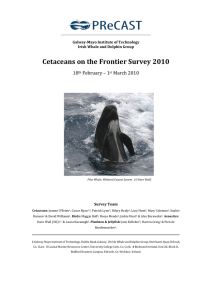Writing as a Technology
advertisement
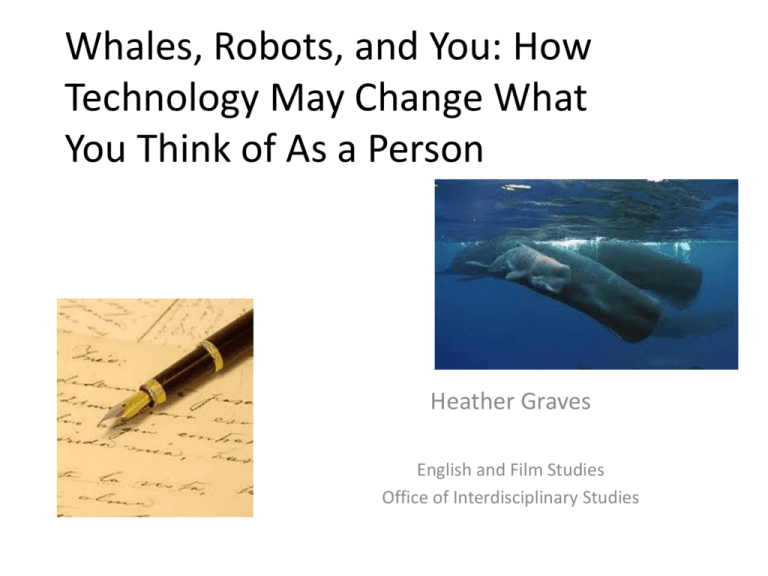
Whales, Robots, and You: How Technology May Change What You Think of As a Person Heather Graves English and Film Studies Office of Interdisciplinary Studies Overview of Talk • • • • What is technology? How is writing a technology? How does writing shape/change reality? How is writing related to the creation and maintenance of knowledge? • How might our relationship to technology and animals change in relation to our increase in knowledge? What is “technology”? • “the branch of knowledge that deals with the creation and use of technical means and their interrelation with life, society and the environment, drawing upon such subjects as industrial arts, engineering, applied science, and pure science” • http://dictionary.reference.com/browse/techn ology What is the point of “technology”? • To improve humans’ quality of life • To advance human (Western, contemporary) civilization • To help humans learn more, to increase our knowledge of biological and natural systems • Other ideas? Some technology has mixed effects Writing as a Technology • How is writing a tool or technology? • What do you use writing to accomplish? • In what ways can writing be hazardous or even dangerous? • What is the relationship between writing and reality? Writing as Technology This “Sample Write-up” by the Mineral of the Month Club is 10 pages long. Mineralofthemonthclub.org • Writing is a technology? • Isn’t it more a transparent medium for thought? • Scientist: do an experiment: “write up” the results? • “Write up” a patient’s medical history or chart? • Is writing just an adjunct/ follow-up to “real” work? Pre-Alphabetic Syllabic Writing Systems Cunieform Source: ourdigitalform.pbworks.com • Pre-alphabetic syllabic writing systems represented the physically heard syllables of language • Ambiguity of these writing systems were not well suited to developing unique ideas • Only specialists could read them Alphabetic Writing Systems Evolution of the Alphabet Source: lucian.uchicago.edu • Greek technological innovation was to use written symbols to represent an abstract unit of phonological structure—the phoneme • Phonemes (b, p, d, t, g, and k) exist in the abstract (to pronounce them, you need an accompanying vowel) • Writing system represented abstract phonological structure (not real speech), enabled the recording and reading of original text (i.e., literacy) Writing as a Tool for Education in Medicine Source: historical.hsl.virginia.edu • Many world cultures preserved medical knowledge, treatments, prescriptions in medical texts • Egypt, Hebrew, Ancient India, Greece, Rome, Islamic cultures, etc., all produced written texts documenting and preserving their culture’s medical knowledge Medicine: Part of the Quadrivium in Medieval European universities Galen’s image of the heart c 1547 Source: scientopia.org • University graduates learned medicine from studying Greek and Islamic texts translated into Latin: Hippocrates, Galen, Avicenna, Haly Abbas, ar-Razi, Albucasis • Medicine was taught through lecture and disputation, supplemented with practice, apprenticeship, and dissection (guided by the same texts) • Not all faculties of medicine included surgery as part of the training Tradition, Writing, Observations, and the “Facts”: Vesalius 1560 Based on dissection of nine women “Vessel feeding the left ovary (e) originates in the renal artery (v) that carries uncleansed blood, while the right ovary is fed from the cleansed blood of the dorsal artery (d)” v d e Belief: Female infants came from uncleansed blood of left ovary; males from the purer blood of the right ovary “Scientific theory” or tradition demanded Vesalius observe this fact of female anatomy (From Nancy Tuana, The Less Noble Sex: Scientific, Religious, and Philosophical Conceptions of Woman’s Nature, [Bloomington, IN: Indiana UP, 1993], p. 140.) Writing creates Ideology • Writing codifies ideas so they become knowledge • Permanent records of ideas (knowledge) can be correct or incorrect, but writing transmits them either way • Culture, history, tradition, and convention can ossify ideas so that even reality cannot dislodge them • Aristotle’s “science” or ideology of human anatomy was not officially discredited for nearly 2000 years Patty Kelly, “A Rhetorical Analysis of Premenstrual Dysphoric Disorder (PMDD) in Canadian Newspapers.” • Analysis of newspaper coverage of PMDD in Canada 1986 – 2007 • “The creation of new mental disorders occurs in social and political contexts and medical classification carry tremendous rhetorical force” (83) • Examined 64 articles in 20 different newspapers over 21 years • Coverage began 1986 with proposed inclusion of PMDD in Diagnostic and Statistical Manual of Mental Disorders (DSM-III-R) (APA’s diagnostic tool and classification system for mental health professionals) Implications of Inclusion in DSM Source: qlinks.ca • Kelly traces the controversial placement of PMDD in the DSM appendix in 1987 and its eventual movement into the manual itself as a full-fledged mental illness • In 1994 PMDD appeared in Appendix B and in the main body of the text under Depressive Disorder Not Otherwise Specified (with insurance code). • Dual placement occurred despite the PMDD subcommittee’s conclusion that “very little empirical evidence existed to support inclusion in DSM-IV” (86) at all. Kelly’s Focus How is the mental illness PMDD constructed for newspaper audiences? How does the newspaper accommodations of expert language affect the representations of women diagnosed with PMDD? Role of DSM and Newspaper Accounts • DSM emphasis on classifications based on empirical observations and scientific evidence establish it as “authoritative within psychiatry” (87). • “medical texts [such as the DSM] enact the values of biomedicine and facilitate the classification of persons” (87). • Kelly traces how discussions of PMDD become linked to discussions of PMS in newspaper accounts • In those accounts premenstrual symptoms eventually become “indicative of a pathological state” and women with premenstrual symptoms become “mentally disordered” (98). Kelly’s conclusion to case study • Of her case study of PMDD, Kelly concludes that “the DSM standardized diagnostic criteria become persuasive not only for the professional audience for whom it was originally intended, but . . . the DSM [also]becomes persuasive for public audiences” (98). • Writing does not just record thought: it shapes and changes reality Other implications for the power of writing? • Writing allows complex thought (Ong) • Writing is the basis for human knowledge, our means for generating it as well as preserving and sharing it across generations • We are living in the 21st Century Knowledge Economy, the basis of which is writing • Writing will be one of the technologies that enables your success as educated professionals 21st Century Advances in Knowledge • Increasing knowledge leads to more sophisticated technology • Technology generates more knowledge and greater understanding • Synergy among knowledge and technology raises important ethical and philosophical questions • It may ultimately require us to re-think our relationships to nature and technology How? Write for 5 minutes • What is our current relationship to technology? • When our technology is smarter than we are, how does that change our relationship to it? • Could/Should machines have “rights” similar to human rights? • What circumstances may lead to machines having “rights”? Human or Machine? Turing Test • Is this speaker a person or a computer? • The Turing Test: test of a machine’s ability to exhibit intelligent behaviour indistinguishable from a human • Alan Turing first raised the question, “Can machines think?” in “Computing Machinery and Intelligence” (1950) • ELIZA, one of most popular program that combines databases of language with rules for forming intelligent sentences Computer-aided Human? Reverse Turing Test • Chess players must prove that a machine is not helping them • Borislav Ivanov, Bulgarian chess player, was searched in December chess tournament • Organizers suspected he was getting help through an electronic device • Problem: Untitled and rated at 2227, he won, scoring 6/9 and a rating performance of 2690 • No device was found How is Fraud Detected in Chess? • Algorithm that can differentiate between human players and computers (move-analysis tests) • Programs can approach from several directions – Sudden change in play – “Top down” analyze moves against past history: "from past games in history, only 2% of humans made that move, while 50% of computers make it” – “Bottom up” compares how humans play versus how computers play Online Poker: Fraud/Collusion Detection Online poker websites • Fraud—someone steals a password and deliberately loses to a third player to clean out second player’s account • Collusion—two or more players manage their game play to go easy on or allow another player to win The computer knows you are cheating • Possible detection strategies: – Catch fraudulent play after the fact through computer analysis and reimburse defrauded player – Create programs that follow and analyze play second by second to detect unfavorable or uncharacteristic play strategies instantly (i.e., sudden change in play strategy) – Program locks player’s account at the first indication of fraud or collusion Machines & Artificial intelligence • Japanese robots that do housework and act as companions • The Windup Girl, Paolo Bacigalupi, includes Emiko, an “engineered being,” who is sentient but not considered “human” What separates humans from machines? animals? Philosophers have identified these characteristics as uniquely human: • Language, our ability to communicate (writing) • Ability to reason • Consciousness • Morality • Development and preservation of tools (machines) and knowledge Personhood • “Humans are considered persons because they have a certain set of characteristics. They are selfaware, intelligent, complex, autonomous, cultured and so on.” Lori Marino, neurobiologist, Emory University • “If we accept this definition—and versions of this are used around the world in constitutions and other legislation—then the latest science is telling us that cetaceans [whales] also qualify.” Whales have distinct cultures • Every clan is unique, with different feeding, migration patterns, child-care preferences, rates of reproduction • Each clan speaks its own dialect that is a declaration of group identity • The dialects are learned (not genetic) and they persist through time (are handed down from generation to generation) • If humans break up a group of whales, they destroy “an ancient, living culture.” Hal Whitehead, biologist, Dalhousie University Whale Brains: Highly Developed • Whale brains differ from other (land) mammals • “an alternative evolutionary route to complex intelligence”—Marino • Extremely well developed limbic system (processes emotions) • Paralimbic lobe located near cortext • Suggests that whales combine emotional and cognitive thinking, leading to sophisticated social communication and selfawareness • Whales are more socially connected, communicative and coordinated than humans Shared Experience • Echolocation, “world’s most powerful imaging device,” may be used like ultrasound to see inside bodies • Whales may also use it to see inside each others’ bodies (what they’ve eaten, whether they’re sick, pregnant, etc.) • Whales can process this information and share it with each other, in effect seeing with one another’s eyes • Widely dispersed whales may form a “single sensory loop” Academic Conference on Cetacean Rights (2010) Cetacean Rights: Fostering a Moral and Legal Change Conference • In spite of some forms of conservation measures, cetaceans are currently treated as resources to be harvested. And yet, many elements point in a different direction. • International law manifests a growing sense of duty to whales and dolphins; contemporary ethical reflection brings new theoretical tools to bear on cetacean moral status; and scientific research gives us novel insights into the complexities of cetacean minds and societies. • In the light of this, scholars from the relevant disciplines drew together to spell out all the implications of such developments, and to build a collective case for the attribution of basic moral and legal rights to cetaceans, great and small. • The conference was held at theHelsinki Collegium for Advanced Studies, University of Helsinki, Finland. Open academic conference : 21st May 2010 Outcome: The Declaration of Rights for Cetaceans Declaration of Rights for Cetaceans: Whales and Dolphins Based on the principle of the equal treatment of all persons; Recognizing that scientific research gives us deeper insights into the complexities of cetacean minds, societies and cultures; Noting that the progressive development of international law manifests an entitlement to life by cetaceans; We affirm that all cetaceans as persons have the right to life, liberty and wellbeing. We conclude that: • Every individual cetacean has the right to life. • No cetacean should be held in captivity or servitude; be subject to cruel treatment; or be removed from their natural environment. • All cetaceans have the right to freedom of movement and residence within their natural environment. • No cetacean is the property of any State, corporation, human group or individual. • Cetaceans have the right to the protection of their natural environment. • Cetaceans have the right not to be subject to the disruption of their cultures. • The rights, freedoms and norms set forth in this Declaration should be protected under international and domestic law. • Cetaceans are entitled to an international order in which these rights, freedoms and norms can be fully realized. • No State, corporation, human group or individual should engage in any activity that undermines these rights, freedoms and norms. • Nothing in this Declaration shall prevent a State from enacting stricter provisions for the protection of cetacean rights. Agreed, 22nd May 2010, Helsinki, Finland Nonhuman Rights Project • “If you are a nonhuman animal, you are simply a thing — property that is owned by a legal person. In legal terms, ‘things’ are invisible to civil judges. They possess no legal rights and no hope of having them. Not so long as they remain legal things.” • “The Nonhuman Rights Project argues that some nonhuman animals should have the capacity to possess common law rights.” • “The passage from thing to person constitutes a legal transubstantiation. As a ‘person’, you have been brought to legal life. The Nonhuman Rights Project seeks to persuade judges that a nonhuman animal has the capacity to possess common law rights.” • “. . . only a legal person has the capacity to have a legal right. That’s why legal personhood is the bull’s-eye for the Nonhuman Rights Project.” • “The great case in 1772 of James Somerset vs. Charles Steuart abolished human slavery in England and sparked a legal conflagration that within decades would consume human slavery everywhere in the Western world.” Nonhuman Rights Project • Legal Working Group has identified five states (USA) that may be receptive to their legal arguments • Creating the documents to legally challenge the status of some animals as “things” • The state deemed most receptive will be selected for the first lawsuit challenging animals’ status (chimpanzees, whales, & elephants) as legal things (that is, not legal persons) • Only legal persons have rights (such as bodily integrity and bodily freedom) Discussion Questions • What are the implications of the Nonhuman Rights Project? • How might this court decision alter our current reality? Discussion Questions • Does the Nonhuman Rights Project have implications for machines? Why or why not? • If so, what are some of these implications?


